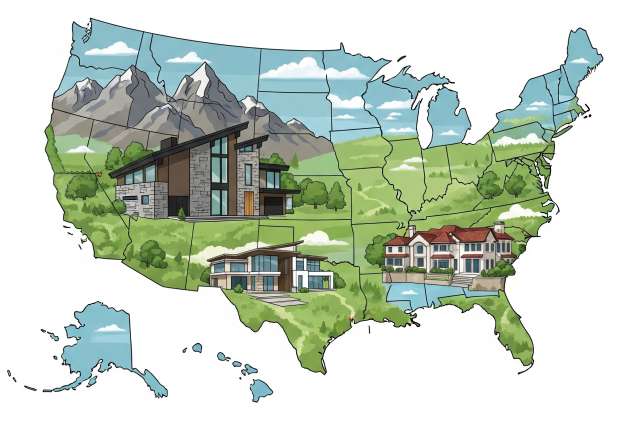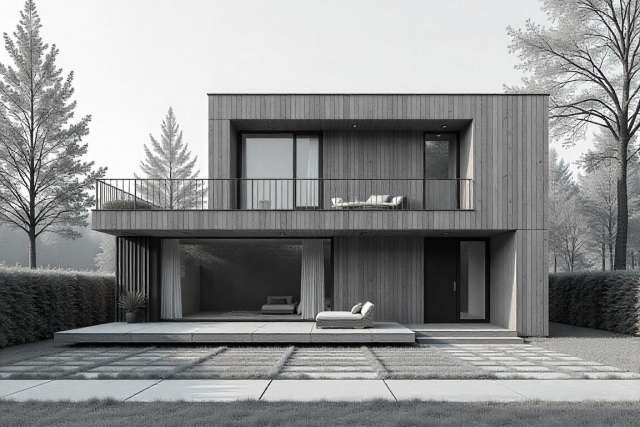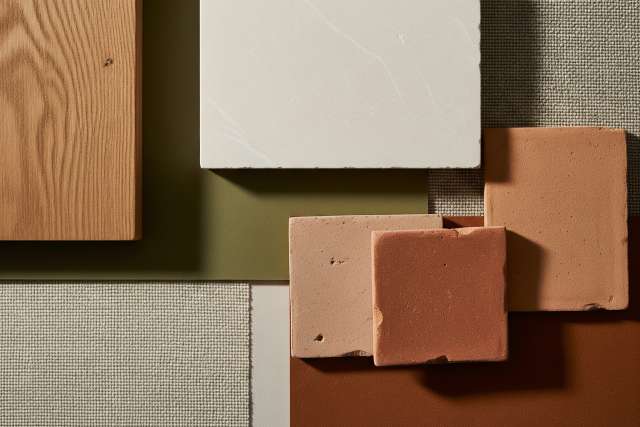The 2025 Custom Home: An In-Depth Analysis of Architectural, Technological, and Lifestyle Trends - part 1

The custom home of 2025 is no longer a static structure but a dynamic, responsive ecosystem. It is an environment meticulously crafted at the intersection of profound cultural shifts, transformative technological capabilities, and an urgent global dialogue on sustainability and resilience. The design and construction of these residences have moved beyond an à la carte selection of features to embody a holistic philosophy where the home is an active partner in the well-being of its inhabitants and the health of the planet. This evolution is shaped by the convergence of three foundational pillars: an unwavering commitment to sustainability, now viewed as the ultimate expression of luxury; a deep integration of wellness principles that engineer spaces for physical and emotional restoration; and the maturation of smart technology into an intuitive, almost invisible, layer that anticipates needs rather than demanding attention.
This report provides a comprehensive analysis of the forces defining the contemporary custom home. It moves beyond a superficial catalog of trends to dissect the underlying drivers—from architectural forms and material choices to high-performance engineering and innovative construction methodologies. We will explore how the boundaries between indoors and outdoors are dissolving, how interior spaces are becoming more fluid and adaptable to support complex modern lifestyles, and how the very materials used are chosen for their authenticity, tactile quality, and environmental integrity. Furthermore, we will present a data-driven examination of the technologies enabling this new paradigm, from solar and geothermal systems to emerging construction techniques like mass timber and 3D concrete printing. Grounded in the economic and regional realities of the 2025 market, this analysis offers a definitive roadmap for clients, architects, and builders. It aims to distinguish fleeting fads from the enduring principles that will promote comfort, beauty, and well-being for years to come.
The New Foundations of Luxury - Core Philosophies Shaping 2025 Homes
The definition of luxury in residential architecture has undergone a fundamental transformation. In 2025, opulence is no longer measured solely by scale or ornate decoration but by the seamless integration of values that enhance quality of life. The most coveted homes are those that provide a sense of sanctuary, operate in harmony with the environment, and leverage technology to simplify, not complicate, daily existence. This section analyzes the four core philosophies that form the new foundation of custom home design: sustainability as a performance metric, wellness as a design mandate, technology as a human-centric tool, and authenticity as the ultimate expression of personal taste. These principles are not independent trends but deeply interconnected forces that collectively define the state-of-the-art residence.
Sustainability as the Ultimate Amenity: Beyond Greenwashing to True Performance
In the 2025 custom home market, sustainability has decisively shed its "buzzword" status to become a non-negotiable tenet of high-end design. Ecological responsibility is no longer framed as an optional extra or a sacrifice; instead, it is viewed as an "exclusive privilege" and a core component of modern luxury. This shift represents a maturation of the market, where discerning clients demand homes that are not only beautiful and comfortable but also resource-efficient, resilient, and built with a conscience. The trend is toward a concept of "Eco-Luxury," where sophistication and environmental stewardship are seamlessly intertwined, and eco-conscious choices are made without compromising on comfort or aesthetic excellence. The pinnacle of this trend is the pursuit of the Net-Zero Energy Home, a residence that generates as much renewable energy as it consumes over the course of a year. Achieving this standard requires a holistic approach that combines on-site energy generation—most commonly through discreetly integrated solar panels—with a high-performance building envelope and advanced mechanical systems. This includes the use of geothermal heating and cooling, high-performance windows designed for specific climates, and advanced insulation techniques that create an airtight yet breathable structure. This commitment to performance is matched by a rigorous focus on material integrity. There is a strong and growing preference for eco-friendly building materials that reduce a home's embodied carbon—the total greenhouse gas emissions associated with its construction. Materials such as reclaimed wood, bamboo, recycled steel, and low-VOC (volatile organic compound) paints are becoming staples in luxury construction, selected for their environmental credentials as well as their artisanal character. This focus on a toxin-free atmosphere is a critical component of the modern healthy home. The industry's leading edge is showcased by publications like
Green Builder Media, whose 2025 Sustainable Products of the Year highlight innovations such as fire-resistant sheathing made with less environmental impact (Arclin Firepoint), open-cell spray foam insulation with high bio-content (BASF ENERTITE X), and wood-alternative building products crafted from upcycled rice hulls (Modern Mill ACRE). Furthermore, sustainability in 2025 is intrinsically linked to resilience and durability. A truly sustainable home is one built to last, minimizing the need for future renovations and the associated waste. This is driving the adoption of robust materials like fiber cement siding, which offers long-lasting performance against harsh weather, pests, and fire. This focus on durability directly connects to the growing demand for climate resiliency, as homeowners increasingly seek designs and materials that offer protection against extreme weather events like hurricanes and wildfires. The trend is further accelerated by regulatory tailwinds, as governments at state and municipal levels—from New York to California and even internationally in China—implement stricter energy codes, carbon caps, and incentives that push the market toward higher standards of green construction.
The Wellness Mandate: Engineering Homes for Physical and Emotional Well-being
The global pandemic fundamentally altered the collective relationship with the home, transforming it from a mere dwelling into the primary environment for work, rest, and refuge. This has elevated holistic well-being from a desirable feature to the very forefront of high-end residential design. The 2025 custom home is conceived as a personal sanctuary, meticulously engineered to support the physical, mental, and emotional health of its occupants. This philosophy, often termed "emotional design," moves beyond pure aesthetics to curate spaces that evoke specific, positive feelings—such as calm, restoration, and energy—thereby reflecting the essence of the homeowner. A key manifestation of this mandate is the proliferation of dedicated wellness spaces. The simple home gym has evolved into a comprehensive wellness center, often featuring yoga studios, dedicated rooms for meditation or mindfulness practice, and spa-grade amenities like infrared saunas, which are becoming essential components of a luxury residence. This focus on self-care extends most powerfully to the bathroom, which is undergoing a radical transformation from a purely utilitarian room into a private spa. Features that were once the exclusive domain of five-star resorts are now becoming standard in custom homes, including aromatherapy steam showers, freestanding soaking tubs with chromotherapy (color therapy), radiant heated floors, and sleek, doorless walk-in showers that enhance both style and accessibility. The American Institute of Architects (AIA) Q1 2025 Home Design Trends Survey confirms a notable uptick in demand for these upscale bathroom features, signaling a broad market shift. Central to the wellness mandate is biophilic design, a philosophy centered on strengthening the human connection to nature within the built environment. This is far more than the strategic placement of houseplants; it is a holistic approach that integrates natural elements to deepen the home's restorative experience. Biophilic design seeks to create homes that "breathe" by incorporating features like living green walls that purify the air, interior courtyards and atriums, and the use of natural materials like wood and stone that provide a tactile link to the outdoors. Perhaps most importantly, it involves the strategic use of expansive windows and glass walls that do not merely let in light but are carefully designed to frame curated landscape views, effectively making the natural surroundings a part of the interior decor. This connection to nature is complemented by a rigorous focus on creating a healthy indoor environment through technology. Advanced, whole-home air and water purification systems are becoming standard, removing pollutants and ensuring a clean, healthy atmosphere. The specification of low-VOC and non-toxic natural materials further contributes to a toxin-free environment. Acoustic insulation is meticulously engineered to create a tranquil soundscape, shielding occupants from exterior noise and promoting a sense of calm. This is powerfully augmented by human-centric lighting systems. These are not merely smart bulbs; they are sophisticated circadian lighting systems that automatically adjust the color temperature and intensity of light throughout the day to support the body's natural 24-hour sleep-wake cycle. By providing bright, cool-toned light during the day to promote alertness and transitioning to soft, warm light in the evening to encourage the natural production of melatonin, these systems can significantly improve sleep quality, focus, and overall health. The convergence of these principles reveals a profound shift in priorities. A home designed for wellness inherently requires high-performance systems for air, water, and light. To operate these systems responsibly, a commitment to sustainable energy generation, such as solar or geothermal, becomes a logical necessity. Managing this complex interplay of high-performance systems then demands a sophisticated yet user-friendly technological backbone. Thus, the pursuit of a "well" home in 2025 naturally leads to a residence that is also sustainable and technologically advanced, demonstrating the deep integration of these core philosophies.
Human-Centric Technology: The Rise of the Anticipatory, Invisible Smart Home
In 2025, smart home technology has reached a pivotal stage of maturity. It is no longer a novelty or a luxury add-on but an indispensable and fully expected component of high-end living. The defining trend is a decisive move away from conspicuous, gadget-focused technology toward a human-centric model characterized by thoughtful, intuitive, and "invisible" integration. The goal is to create an environment where technology serves the occupants' needs seamlessly and in the background, enhancing comfort and ease without demanding constant attention or disrupting the aesthetic serenity of the space.The most sophisticated custom homes now feature anticipatory automation, where AI-powered systems learn residents' routines and proactively adjust the environment to meet their needs. For instance, a home's entry system might use facial recognition to identify a homeowner upon arrival, triggering a personalized scene that adjusts lighting to a preferred level, sets the thermostat to the perfect temperature, and begins playing a favorite music playlist. This all occurs without a single button press, representing a shift from reactive commands to a proactive, intelligent environment. This is achieved through discreet interfaces and controls that blend into the architecture, preserving the visual tranquility of the home and avoiding the "cold digitalia" of earlier, more obtrusive smart home systems.The most impactful AI applications are often the most subtle. While flashy home robots remain largely conceptual, the real revolution is in preventative and practical technology. Smart water monitoring systems, for example, use sensors and AI to learn a home's water usage patterns, allowing them to instantly detect leaks—from a slow drip to a burst pipe—and automatically shut off the main water supply to prevent catastrophic damage. Similarly, smart appliances can now self-diagnose performance issues and proactively alert a service team before the homeowner even notices a problem, enhancing longevity and convenience. In the realm of security, AI has enabled a new level of precision through advanced object and facial recognition, allowing systems to distinguish between a delivery person, a familiar guest, and a potential intruder, thereby reducing false alarms and providing more meaningful alerts.Homeowners expect this complex web of devices and systems—spanning lighting, climate, security, and entertainment—to be managed from a single, intuitive platform, typically a smartphone app or through integrated voice assistants like Alexa or Google Home. However, the promise of universal compatibility remains a work in progress. While the Matter standard aims to unite the smart home world, its adoption is still evolving, and ensuring seamless interoperability between devices from different brands remains a key challenge for builders and integrators in 2025. As homes become ever more connected, the security of these integrated systems is paramount. Leading builders and technology vendors are responding by offering systems with advanced encryption, regular security updates, and secure data protocols to protect homeowners' privacy and data.
The Return to Authenticity: Craft, Personalization, and the Rejection of the Generic
In a world increasingly dominated by mass production and digital interfaces, a powerful counter-current is shaping the aesthetic of the 2025 custom home: a profound return to authenticity. Discerning clients are rejecting "cookie-cutter" designs in favor of spaces that tell a personal story and reflect their unique tastes. This manifests as a deep appreciation for artisanal craftsmanship, bespoke elements, and materials that possess character and a tangible human touch. A central tenet of this movement is the celebration of the handmade over the mechanical and synthetic. This is evident in the rising demand for features that showcase artistry, such as custom millwork, intricate coffered ceilings, bespoke lighting fixtures crafted from hand-blown glass or wrought iron, and hand-painted or intricate mosaic tiles inspired by Mediterranean and Moroccan patterns. This appreciation for craft extends to a rejection of artificiality. There is a strong and growing sentiment against "faux finishes" like luxury vinyl tile (LVT), thin brick veneers, and look-alike wood laminates. Leading architects are championing the use of genuine, natural materials, memorably likening them to "fruits and veggies" for the home, in contrast to the synthetic "junk food" of their imitations. This philosophy suggests that the materials we live with should be as honest and healthy as the food we consume.
This search for authenticity also leads to an embrace of "playful imperfection". Rather than pursuing a flawless, machine-made aesthetic, designers are incorporating materials and forms that show the mark of the hand. This can include textures that are intentionally "droopy, puffy, or smudged," offering a soft, nostalgic antidote to the hard-edged seriousness of modern life. This aesthetic values the unique character found in natural materials—the grain of a wood plank, the veining in a slab of marble, the subtle variations in a handmade tile—as features to be celebrated, not flaws to be eliminated.
This desire for authenticity is fundamentally intertwined with the rise of technology in the home. The increasing sophistication and ubiquity of invisible, AI-driven automation creates a sensory and psychological need for a counterbalance. As the home's function becomes more automated and mediated by nonhuman processes, its form must become more tactile, warm, and authentic to create a balanced and human-centric environment. The more our homes do for us in the background, the more we crave physical surroundings that feel grounded, personal, and real. In this context, the seamless technology becomes the quiet stage upon which the artisanal materials and bespoke details can truly shine.
Ultimately, this leads to a focus on deep personalization and enduring elegance. Homeowners are moving away from chasing fleeting trends and are instead investing in timeless designs and high-quality materials, especially for foundational elements like countertops, cabinetry, and flooring. Customization now goes far beyond selecting from a catalog; it involves commissioning truly bespoke elements and choosing architectural styles that resonate on a personal level, whether that includes a custom wine cellar, a dedicated art studio, or a state-of-the-art home theater. The 2025 custom home is, above all, a unique reflection of its owner's life and values.





